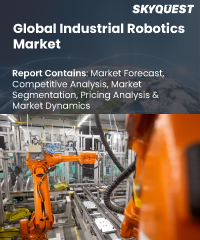
Product ID: SQMIG20I2180

Report ID:
SQMIG20I2180 |
Region:
Global |
Published Date: March, 2024
Pages:
202
|
Tables:
72 |
Figures:
75
Global Industrial Robotics Market size was valued at USD 26.52 Billion in 2022 and is poised to grow from USD 29.30 Billion in 2023 to USD 65.14 Billion by 2031, at a CAGR of 10.50% during the forecast period (2024-2031).
The Global Industrial Robotics Market stands as a transformative force within modern manufacturing, epitomizing the convergence of cutting-edge technology and industrial prowess. This market is defined by the utilization of robotic systems to automate and elevate manufacturing and production processes across a spectrum of industries. Industrial robots, equipped with advanced sensors, actuators, and intelligent programming, have become the cornerstone of enhancing efficiency, precision, and productivity in factories and industrial facilities worldwide.
The fundamental purpose of the Global Industrial Robotics Market lies in revolutionizing conventional manufacturing paradigms. By integrating industrial robots into various sectors, manufacturers aim to amplify operational efficiency, streamline complex workflows, and reduce human intervention in tasks that demand precision and repeatability. The market's offerings span a broad array of applications, including welding, assembly, material handling, and more, thereby establishing a seamless nexus between technology and industrial ingenuity.
A potent driving force propelling the growth of the Global Industrial Robotics Market is the insatiable pursuit of operational excellence. Companies are drawn to industrial robotics due to their capacity to significantly increase production output while maintaining consistent quality standards. Furthermore, the push towards Industry 4.0 and the Industrial Internet of Things (IIoT) fosters the integration of robotics into interconnected and smart manufacturing ecosystems, enabling real-time data analysis, predictive maintenance, and adaptive manufacturing strategies.
However, the path to industrial robotics adoption is not devoid of challenges. One of the primary constraints is the initial capital investment required for procuring, integrating, and training personnel to operate these advanced systems. The intricacies of programming and maintenance can pose hurdles, particularly for smaller enterprises with limited resources. Moreover, concerns about the displacement of human jobs and the need for workforce upskilling create an intricate balance between technological advancement and the preservation of livelihoods.
The Global Industrial Robotics Market grapples with multifaceted challenges, including the need for interoperability between diverse robotic systems, addressing cybersecurity vulnerabilities in interconnected environments, and ensuring robots' adaptability to dynamic and agile production demands. Additionally, as robotics becomes increasingly ubiquitous, navigating regulatory frameworks and ethical considerations surrounding human-robot collaboration and liability poses intricate challenges.
Amidst these challenges, a myriad of opportunities emerges. The integration of Artificial Intelligence (AI) and Machine Learning (ML) enables robots to become more intuitive, responsive, and adaptable to evolving production needs. Customized robotic solutions catering to specific industry requirements hold immense potential, as does the expansion of collaborative robot (cobots) capabilities that allow humans and robots to work harmoniously. The rise of service robotics, including healthcare and logistics applications, presents a fascinating avenue for diversification and market expansion.
US Industrial Robotics Market is poised to grow at a sustainable CAGR for the next forecast year.
Our industry expert will work with you to provide you with customized data in a short amount of time.
REQUEST FREE CUSTOMIZATIONWant to customize this report? This report can be personalized according to your needs. Our analysts and industry experts will work directly with you to understand your requirements and provide you with customized data in a short amount of time. We offer $1000 worth of FREE customization at the time of purchase.

Product ID: SQMIG20I2180